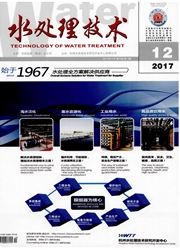

 中文摘要:
中文摘要:
以小试规模A^2/O工艺结合活性污泥数学模型(ASM2D),考察了实际污水中污泥龄为8、10、12、15d时对脱氮除磷的影响,并建立了AVO数学模型进行模拟与优化。结果表明,除碳和脱氮率基本不受污泥龄的影响,去除率分别为80%~88%和57%~65%;聚磷菌释磷和吸磷受污泥龄的影响较大,以12d时脱氮除磷效率为最高,出水基本能达到城镇污水处理厂污染物排放一级标准;COD、NH3-N和P在各反应器内的模拟值与实测值较为接近,在短污泥龄时受模型结构限制,NO3^·-N模拟值与实测值相差较大,在长污泥龄时NO3^·-N的模拟精度达93%,所建立的模型可较好地模拟工艺运行;通过分析模拟优化结果,得出最佳污泥龄约为13d,与试验结果基本相吻合。
 英文摘要:
英文摘要:
Based on a laboratory-scale A^2/O process acclimated with real wastewater, and combining with activated sludge model, research on effect of SRT of 8, 10, 12 and 15 d on biological nutrient removal was done,and simulation and optimization with the established A2/O model were made.The results indicated that COD and nitrogen removals were rarely influenced by SRT,with the removal efficiency of 80-88% and 57-65% respectively,while P release and uptake of PAOs were largely affected by sludge age.Premoval efficiency was the best at the SRT 12 d and the effluent concentrations could comply with the first class discharge standard of pollutants for municipal wastewater treatment plant.The simulated values for COD,NH3-N and P in three reactors were close to the measured values.Due to practically being limited by model structure,the difference between the simulated and measured values for NO3^·-N was great at the short SRT,while at the long SRT the simulating precision was above 93%,indicating that the established model could satisfactorily simulate the process operation. After analysing the optimizing result the optimal SRT was 13 d,which approached to the experimental resets.
 同期刊论文项目
同期刊论文项目
 同项目期刊论文
同项目期刊论文
 期刊信息
期刊信息
